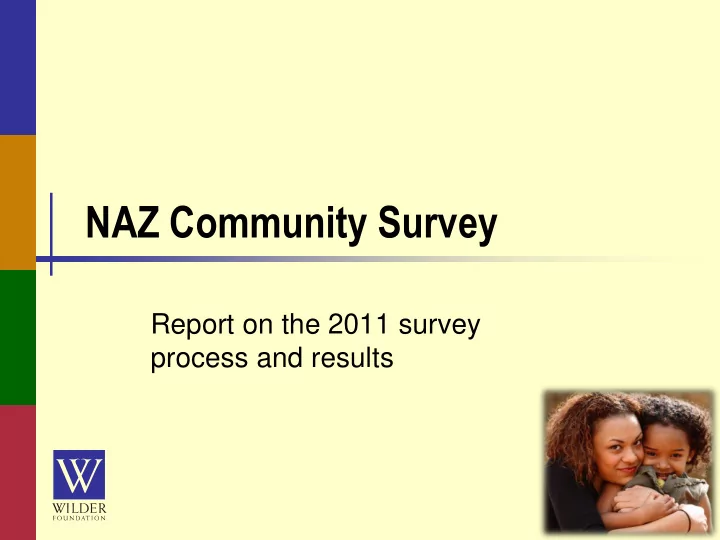

NAZ Community Survey Report on the 2011 survey process and results
NAZ Mission To build a culture of achievement in a geographic Zone in North Minneapolis to ensure all youth graduate from high school college-ready wilderresearch.org
Purposes of community survey Gather in-depth data about how the kids in the zone are doing –– in and out of school Assess “microclimate” and changes in it Measure progress toward key outcomes 2010 survey = Measure NAZ starting point wilderresearch.org
Development of survey NAZ Engagement Team and evaluators decided together: • Survey purposes Why? • Survey topics and questions What? • Best ways to engage respondents How? wilderresearch.org
Key to success: Engagement Team Successful survey depended on the team Familiarity with the Zone and its residents Training in social science methods Hard work, enthusiasm, persistence, and good judgment Support, coaching, and oversight from NAZ staff wilderresearch.org
Survey was representative of the Zone Lowry Ave N N 3rd St Penn Ave N Dupont Ave N 2 9 t h A v e N James Ave N 26th Ave N 23rd Ave N ○ Completed interview (367) Refusal (71) W Broadway Ave wilderresearch.org
367 respondents, May – October 2010 Randomly selected households Screened for kids in household 90% in-person, 10% by phone 47% response rate Distributed across the Zone $10 gift card wilderresearch.org
Race of respondents American Indian, 3% African Native, 2% Hispanic or Latino (any race), 5% Multiracial, 7% Asian, 12% Black / African American, 57% White, 13% wilderresearch.org
Number of children per household 5 or more children, 1 child, 14% 24% 4 children, 14% 3 children, 2 children, 19% 29% wilderresearch.org
Number of adults per household 1 adult, 3 or more 28% adults, 31% 2 adults, 41% wilderresearch.org
Ages of children (N=1,043 in survey) 14-18, 22% 0-2, 27% 11-13, 14% 3-5, 12% 6-10, 25% wilderresearch.org
Results wilderresearch.org
Collective efficacy Social cohesion: How much people feel connected to each other Informal social control: How much neighbors will take action together to promote the well- being of the overall community Scale 1 = lowest possible 4 = highest possible 2.5 = midpoint (even balance negative/positive) wilderresearch.org
Perceptions of social cohesion wilderresearch.org
Perceptions of informal social control wilderresearch.org
Residents’ perceptions of safety “This neighborhood is a safe place to raise a child” wilderresearch.org
What kind of preschool education? 100% 90% 80% 70% Not in school 60% Don't know 50% Unable to categorize 40% K-12 school 30% Preschool or child care 20% 10% 0% Age 0-2 Age 3-5 wilderresearch.org
Kids in the survey attend 145 different schools 17% Minneapolis Public Schools (N=35) 13% 52% Public charter schools (N=24) Non-Minneapolis public schools (N=34) Other (N=52) 18% “Other” includes Private/parochial (2%), “Don’t know” (3%), Not in school (1%), and named schools that could not be categorized (9%) wilderresearch.org
Parents rate their children’s schools highly “Agree” + “Strongly Agree” I feel welcome in my child’s school 97% My child receives a high-quality education 87% at school I have to struggle to get my child’s school 21% to provide services that my child needs wilderresearch.org
Engagement in education varies for children and parents Parents report that: Child cares about doing well in school: 81% Child does just enough schoolwork to get by: 31% Parent checks that the child has completed homework: 83% wilderresearch.org
In the last 12 months, has any child in the home participated in … An after-school activity A mentoring program 14% 27% 31% 55% 31% 42% Yes No, but wanted child to No, and did not feel the need wilderresearch.org
Parents’ highest educational hopes and expectations for kids Leave high school 0% before finishing 1% 4% Graduate from high school 11% Complete a vocational 2% Aspiration or technical program 6% Expectation Complete a two-year 8% college degree 18% Complete a four-year 20% college degree 29% Complete a graduate 66% or professional degree 35% wilderresearch.org
Health and nutrition 87% report getting health care for kids is “not at all” a problem ─ Routine care ─ When kids are sick Harder for households with older kids (age 14+) Easier for households with younger kids (0-5) wilderresearch.org
Housing Median length at current address = 2 years 25% lived at current address < 1 year ─ 71% moved just once in that time ─ 15% moved twice ─ 13% moved 3 – 5 times wilderresearch.org
Summary of main findings Safety is a significant concern Parents express very favorable perceptions of their children’s schools, and have high aspirations for their children Children are scattered among many different schools Findings are a snapshot of NAZ before most program activities began Completion of survey is a significant achievement wilderresearch.org
Issues to consider Help parents become knowledgeable partners of schools ─ Formulate realistic and high expectations for selves and schools Use findings to identify groups with high needs ─ Also identify barriers to access, and plan targeted services Continue to build collective efficacy wilderresearch.org
Recommend
More recommend